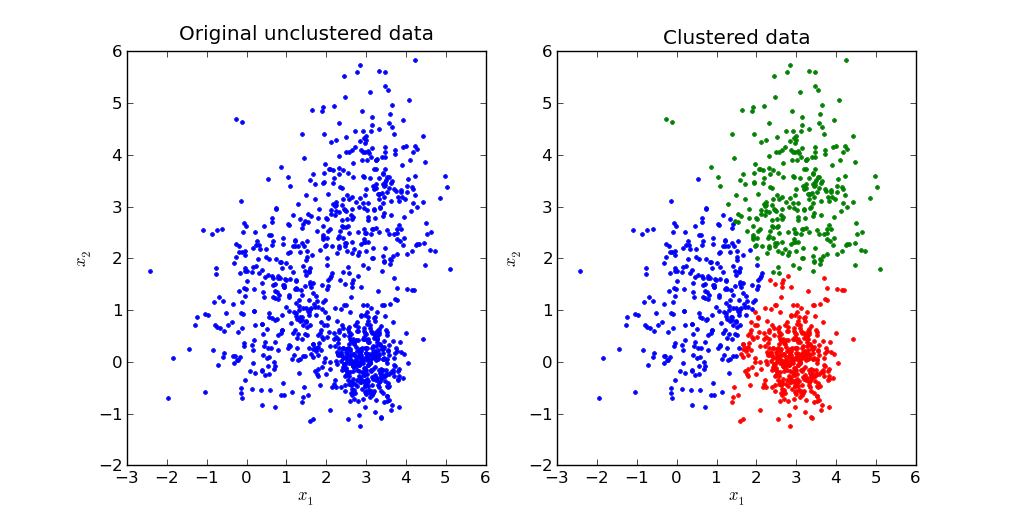Artificial Neural Network - With Back-propagation Algorithm(Supervised Learning)
A skilled practitioner of machine learning can use artificial neural networks (ANN's) to teach a computer to do virtually anything. Many respectable researchers in the field believe to be the panacea algorithm; the one algorithm for solving every hard problem (in a certain- narrow sense of-course !)
 |
| image taken from the web |
Neural networks have been around for quite some time now but they still are a topic on which massive amounts of research is ongoing.
The whole idea behind a neural net is to mimic the brain. The argument is that, like an average Joe who can master multiple languages and skills during his lifetime using the same set of neurons in his brains (it's not as straightforward as that- but what the hell) the same algorithm which tries to mimic the biological neurons should be able to learn anything if used properly.
ANN based applications are ubiquitous now-a-days and it is an important tool to to add to your repertoire as an analyst.
Writing code for an ANN is relatively straightforward; using it effectively on the other hand is somewhat of an art. It takes time , patience and practice.
I have provided below the python code (Yes python, I guess it was time to switch from MATLAB) for an artificial neural network which trains using the
back-propagation algorithm. The code is plug and play but as a user, you are expected to know how to use a neural network. The finer points have been mentioned below. You can also download the code from my
Github page. As always, contributions to the code are welcome and appreciated.
Additional Requirements- Numpy (I use the Spyder IDE)
The code:
##########################################################################3
import numpy as np
def sgm(x,derivative=False):
if not derivative:
return 1/(1+np.exp(-x))
else:
out = sgm(x)
return out*(1.0-out)
def linear(x,derivative=False):
if not derivative:
return x
else:
return 1.0
def guassian(x,derivative=False):
if not derivative:
return np.exp(-x**2)
else:
return -2*x*np.exp(-x**2)
def tanh(x,derivative=False):
if not derivative:
return np.tanh(x)
else:
return (1.0-np.tanh(x)**2)
class backPropagationNetwork:
layerCount = 0
shape = None
weights = []
layerTransferFunc = []
# constructor function for the class
def __init__(self, layerSize,layerTransferFunc = None):
# layerSize is the Architecture of the NN as (4,3,1)
self.layerCount = len(layerSize)-1 # input layers is just a buffer
self.shape = layerSize
# for the forward pass maybe.
self._layerInput = []
self._layerOutput = []
self._previousWeightDelta = []
for(l1,l2) in zip(layerSize[:-1],layerSize[1:]):
self.weights.append(np.random.normal(scale=0.1,size=(l2,l1+1)))
# add for each weight matrix a matrix in _previousWeightDelta for previous values
self._previousWeightDelta.append(np.zeros(shape=(l2,l1+1)))
if layerTransferFunc is None:
layerTransferFunc = []
for i in range(self.layerCount):
if i == self.layerCount - 1:
layerTransferFunc.append(linear)
else:
layerTransferFunc.append(sgm)
else:
if len(layerTransferFunc) != len(layerSize):
raise ValueError("Incompatible no of transfer functions.")
elif layerTransferFunc[0] is not None:
raise ValueError("no transfer functions for input layer.")
else:
layerTransferFunc = layerTransferFunc[1:]
self.layerTransferFunc = layerTransferFunc
# forward run/pass
def run(self,X):
# no of training examples
m = X.shape[0]
# initialize/ clear out the input and output list from previous run
self._layerInput = []
self._layerOutput = []
# Forward pass
for i in range(self.layerCount):
if i == 0:
layerInput = self.weights[0].dot(np.vstack([X.T, np.ones([1,m])])) # vstack(a,b) stacks matrix/vector b below matrix/vector a
else:
layerInput = self.weights[i].dot(np.vstack([self._layerOutput[-1], np.ones([1,m])]))
self._layerInput.append(layerInput)
self._layerOutput.append(self.layerTransferFunc[i](layerInput))
return self._layerOutput[-1].T
def trainEpoch(self,X,Y,trainingRate ,momentum ):
# trains the network for one epoch
delta = []
m = X.shape[0]
# forward pass before we can compute the gradient by back propagation
self.run(X)
for i in reversed(range(self.layerCount)): # reverse as the backpropogation work in reverse order
if i == self.layerCount-1: # if this is for the preactivation at the output
outputDelta = self._layerOutput[i] - Y.T # this is also the gradient at output if we take the least square error function
error = np.sum(outputDelta**2) # sum of all the elements along all dimensions
delta.append(outputDelta*self.layerTransferFunc[i](self._layerInput[i],True)) # '*' operator is for coordinate wise multiplication
else:
deltaPullback = self.weights[i+1].T.dot(delta[-1])
# this is the gradient at the activation of the hidden layer (i+1), note that i = 0
# is for hidden layer 1.
delta.append(deltaPullback[:-1,:]*self.layerTransferFunc[i](self._layerInput[i],True)) # this is the gradient at the preactivation at hidden layer (i+1)
for i in range(self.layerCount):
deltaIndex = self.layerCount - 1 - i
# delta[0] is preactivation at output and so on in backward direction
if i == 0:
layerOutput = np.vstack([X.T,np.ones([1,m])])
# for W0 the delta (preactivation) is input layers
else:
layerOutput = np.vstack([self._layerOutput[i-1],np.ones([1,self._layerOutput[i-1].shape[1]])])
# _layerOutput[0] contains the activation of the hidden layer 1 and so for Wi we need _layerOutput[i-1]
weightDelta = np.sum(layerOutput[None,:,:].transpose(2,0,1)*delta[deltaIndex][None,:,:].transpose(2,1,0),axis=0)
weightDelta = trainingRate * weightDelta + momentum*self._previousWeightDelta[i]
self.weights[i] -= weightDelta
self._previousWeightDelta[i] = weightDelta
return error # incase useful
if __name__ == "__main__":
print ("welcome to neural network")
data_file=raw_input("please mention the name of your training set file\n")
d=np.genfromtxt(str(data_file),delimiter=',')
z=np.shape(d)
print ("your data set has %i datapoints a\n"%z[0])
print ("And there are %i columns\n"%z[1])
nx=int(raw_input("how many of the %i columns are inputs ?\n"%z[1]))
ny=z[1]-nx
x=[]
y=[]
for p in range(z[0]):
x.append(d[p,0:nx])
y.append(d[p,nx:])
X = np.array(x)
Y= np.array(y)
net_def=[int(nx)]
print net_def
qwe=raw_input("how many epochs ?\n")
hlc=int(raw_input("how many hidden layer do you want ?\n"))
print int(hlc)
for n in range(int(hlc)):
a=raw_input("how many units in layer %s\n"%(n+2))
net_def.append(int(a))
net_def.append(ny)
m=float(raw_input("please define momentum:\n"))
alph=float(raw_input("please define learning rate:\n"))
print("You can choose from a host of transfer functions :-sigmoid(sgm),linear(linear),gaussian(gaussian),tanh(tanh)\n")
tff=str(raw_input("choose on of the transfer functions(mentioned in paranthesis above)\n"))
tup=tuple(net_def)
layerTransferFunc = [None]
for n in range(len(tup)-1):
layerTransferFunc.append(str(tff))
bpn = backPropagationNetwork(tup)
maxIteration = int(qwe)
minError = 1e-5
for i in range(maxIteration+1):
err = bpn.trainEpoch(X,Y,momentum=float(m),trainingRate=float(alph))
if i%100 == 0:
print "iteration {0}\t error: {1:0.6f}".format(i, err)
if err <= minError:
print "Minimum error reached as iteration {0}".format(i)
break
Ycomputed = bpn.run(X)
for i in range(np.shape(X)[0]):
print "Input: {0}\n Output: {1}".format(X[i],Ycomputed[i])#tup
print(bpn.shape)
print(bpn.weights)
########################################################################
How to use : This is the art part.
First of all, your data should be munged properly on a spreadsheet with normalized decimal values and binary tags and subsequently be saved as a .csv file or a text file.
Next, as always, all your initial columns must represent the inputs to the neural network and the rest have to represent the corresponding output (remember that we are doing supervised learning). Every row is one data point i.e. one training example. The program will ask you for these when you run it and based on that, it will decide the number of nodes in the input and output layer.
It will then ask you about the number of hidden layers and the number of nodes in each layer.
You will also be prompted to define the learning rate and momentum; both of which are values between 0 and 1.
You will also be asked to decide the number of epochs . Epochs is just a fancy way of depicting the number of times the algorithm uses your entire dataset to train the network. It is usually in the order of millions.
The learning rate is somewhat analogous to the size of steps that you want to take while trying to solve an optimization problem and the momentum can be intuited as a coefficient that decides the amount of impact that the already learnt parameters will have on the subsequent learning steps. You may also need to decide if you have sufficient data. In machine learning , more data is almost never a bad thing (if you are willing to compromise on the computational cost front).
Deciding the network architecture (number of hidden layers and their nodes) and cleverly choosing inputs and outputs along with fine-tuning your learning rate and momentum parameters may take some time and experimentation. It is all about finding the right balance . After the error converges to a level of you satisfaction, you can use the network for doing further prediction/classification/regression etc.
All you have to do is declare your new input vector as a numpy array (lets call it "R") and write the folloing in the command window :-
#################
Y=bpn.run(R)
print Y
###################
you can also print the weight matrix by using the following command:-
##########
print weights
###########
Acknowledgements:
I must thank the following two people who unknowingly helped me create this post:
This Amazing Person's
Youtube tutorial and
This like minded fellow programmer's
Github page












